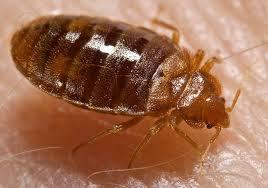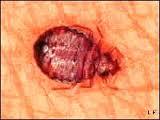Bed Bugs Control Information
Description
Bed Bugs
 Bed bugs are persistent. Eradicating, exterminating or just killing an entire infestation requires persistence. They can hide in extremely small cracks and crevices making it difficult to locate breeding sites. Bedbugs are rarely seen in daylight. They emerge from their hiding spots at night. Bed bugs can live a year or longer without food (blood) and thus stay in their hiding places. They can travel long distances and survive in suitcases, clothing, vehicles, aircraft, cruise ships and other modes of transportation. Bed bug females lay about 300 eggs. Bed bugs hatch from eggs in 10 days.
Bed bugs are persistent. Eradicating, exterminating or just killing an entire infestation requires persistence. They can hide in extremely small cracks and crevices making it difficult to locate breeding sites. Bedbugs are rarely seen in daylight. They emerge from their hiding spots at night. Bed bugs can live a year or longer without food (blood) and thus stay in their hiding places. They can travel long distances and survive in suitcases, clothing, vehicles, aircraft, cruise ships and other modes of transportation. Bed bug females lay about 300 eggs. Bed bugs hatch from eggs in 10 days.
Bed bugs feed by piercing skin with an elongated beak. Saliva is injected, containing an anesthetic to reduce pain, and an anticoagulant to keep blood flowing. The reaction to bed bug bites varies among individuals, from no reaction to severe skin inflammation and irritation.
Symptoms of a Bed Bug Infestation
 Most bug problems are not detected until someone has been bitten. The bite is painless. The salivary fluid injected by bed bugs typically causes the skin to become irritated and inflamed, although individuals can differ in their sensitivity. A small, hard, swollen, white welt may develop at the site of each bite. This is accompanied by severe itching that lasts for several hours to days.
Most bug problems are not detected until someone has been bitten. The bite is painless. The salivary fluid injected by bed bugs typically causes the skin to become irritated and inflamed, although individuals can differ in their sensitivity. A small, hard, swollen, white welt may develop at the site of each bite. This is accompanied by severe itching that lasts for several hours to days.
A bed bug infestation can be recognized by blood stains from crushed bugs or by rusty (sometimes dark) spots of excrement on sheets and mattresses, bed clothes, and walls. Fecal spots, eggshells, and shed skins may be found in the vicinity of their hiding places. An offensive, sweet, musty odor from their scent glands may be detected when bed bug infestations are severe.
Disease and Health Risks
Skin reactions are commonly associated with bed bugs, which result from the saliva injected during feeding. Some individuals, however, do not react to their bite, whereas others note a great deal of discomfort often with loss of sleep from the persistent biting. The most commonly affected areas of the body are the arms and shoulders. Reactions to the bites may be delayed; up to 9 days before lesions appear. Common allergic reactions include the development of large wheels, often >1cm, which are accompanied by itching and inflammation. The wheels usually subside to red spots but can last for several days. Scratching may cause the welts to become infected. Bullous eruptions have been reported in association with multiple bed bug bites and anaphylaxis may occur in patients with severe allergies. In India, iron deficiency in infants has been associated with severe infestations. It has been suggested that allergens from bed bugs may be associated with asthmatic reactions.
Bed bugs have been implicated in the transmission of a wide variety of infectious agents, although their status as vectors is uncertain. It has been suggested that they might play a role in the spread of hepatitis B, however, experimental evidence does not support this.
Some individuals respond to bed bug infestations with anxiety, stress, and insomnia.
Hiding Places
Bed bugs can live in almost any crevice or protected location. They will usually stay close to their food source (blood) but can rapidly spread through a multiple residence building, hotel or other accommodations. The most common place to find them in bed. Bed bugs often hide within seams, tufts, and crevices of the mattress, box spring, bed frame, and headboard.
More Information and Tips on Bed Bug:
- Once thought to be folklore, but now a common nuisance in all areas - not just cities
- They are like a hitchhiker and travel home with you in suitcases, on clothing or backpacks, etc.
- They do not care if your house is clean or dirty
- Professional treatment is essential
- Price of treatment depends on location, size of the house, number of bedrooms, number and size of beds, sofa beds, etc.
- Adults about? inch long, reddish brown oval, flattened bodies - look somewhat like an apple seed
- Do not fly but move rapidly - can crawl great distances for a meal
- Females lay whitish-colored eggs the size of a speck of dust in secluded areas
- Females lay up to 5 eggs a day and 500 in a lifetime
- Newly hatched nymphs are lighter in color than the adult and about the size of a pinhead
- Nymphs shed their skin 5 times in a month before maturing, feeding between each molt, producing 3 or more generations per year
- Only feed on the blood of people and animals which they get by piercing the skin
- Prefer human blood but may also bite pets
- Require blood to survive but can live up to a year without feeding
- Reactions can range from red itchy welts to little or no swelling
- May leave 3 bites in a row - breakfast, lunch, and dinner
- Mostly active at night - You will seldom feel them bite
- Do not have nests but hide in mattresses, upholstered furniture, behind baseboards and in clothing
- Their presence is indicated by dark spots and stains on sheets and mattresses from blood and their feces
- There may also be eggs, eggshells, and molted skin
- To reduce spread - clear any clutter on floors, repair holes and damage in walls, reglue peeling wallpaper, repair peeling paint, fix any damage where bed bugs may be hiding
- Seal or caulk cracks and crevices near beds, around heating and AC units, seal pipes and conduits.
Details
| Date Added | 2019-03-26 |
| Product Id | 10461411 |






